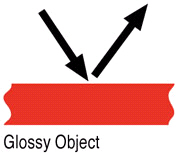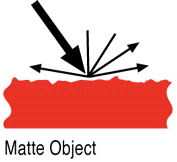When light strikes a sample, the development of perceived color begins. The phenomena taking place at the surface of the sample where the light first interacts are important in understanding the perceived color and appearance.
If the surface of the sample is very smooth (high gloss), light will be reflected from that smooth surface like a mirror. Here, two important things happen. First, the incident light will be reflected from the smooth surface at the same angle as the incident light. Second, and just as important, the reflected light will have the some color as the incident beam. Light reflected in this manner is not altered or changed other than its direction. This is the “specular component.”

Specular Surface Scattering or Diffuse Reflection
If the surface of the sample is not smooth but textured and irregular (matte), the incident light beam will be reflected from the surface in many directions. At each point where the light interacts with the surface, the reflected light beam will not be altered or changed in color just as in the previous example. However, due to the texture of the object, light will be reflected at many angles, or reflected diffusely. This phenomenon will make the sample appear lighter in shade or appearance. However, it is important to note the color of the scattered light beam is still identical in composition to the incident beam.

Gloss
Gloss is the direct result of Specular Reflection and First Surface Scattering. The smoother a sample surface the higher the gloss will be. Light reflected from a smooth, high gloss surface has the same quality as the light striking that high gloss surface. Gloss does not contribute to the color of a sample. Gloss will affect appearance, which is the total effect of all that person observes. In general, the higher the gloss, the darker the object will appear, and the lower the gloss, the lighter the object will appear. It is critical to attempt to match gloss as closely as possible between color match and target for accurate comparisons.